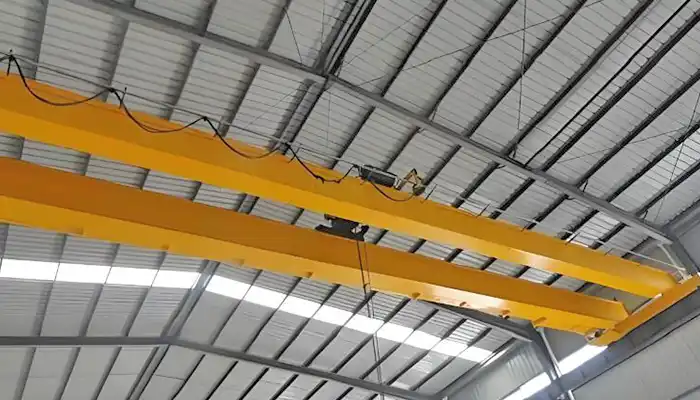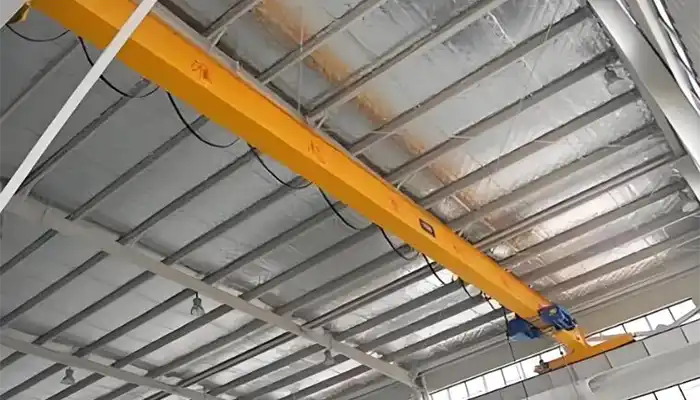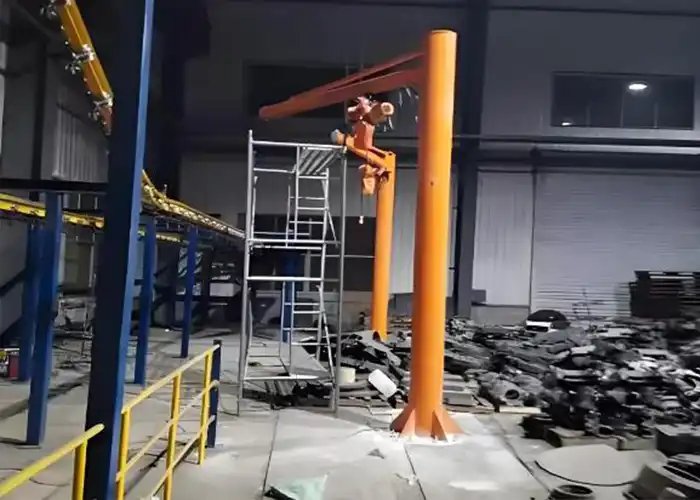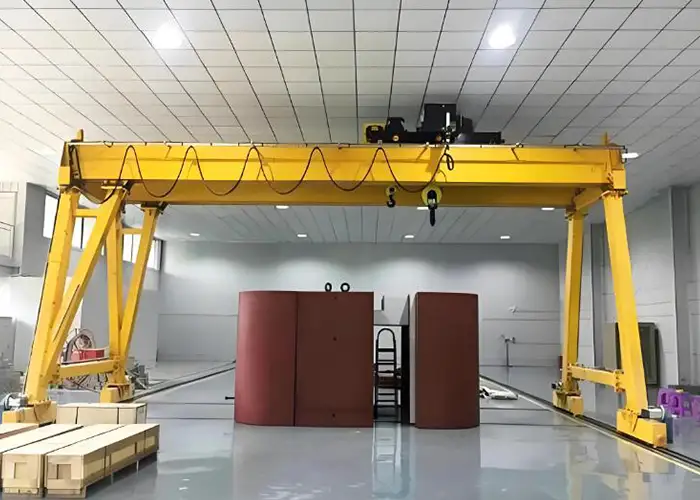Optimizing Silk Weaving:Overhead Crane Systems in Azerbaijan
Efficient overhead crane systems in Azerbaijan's silk and textile industry streamline silk weaving & fabric handling, enhancing productivity and precision.
In the silk and textile industry, cranes are indispensable for maintaining efficient material handling and operational processes. In Azerbaijan, key locations like the Sheki Silk Workshops and Baku Textile Mills rely heavily on robust crane systems to streamline their production workflows. These cranes play a pivotal role in lifting, transporting, and positioning raw materials, finished products, and heavy machinery within these specialized facilities.
The Sheki Silk Workshops, renowned for their traditional silk production techniques, and the Baku Textile Mills, recognized for their modern manufacturing capabilities, showcase the diverse applications of crane technology in meeting the industry's unique demands. In the dynamic environment of silk weaving and textile manufacturing, where precision and speed are crucial, the right crane systems ensure smooth operations from start to finish.
At the Sheki Silk Workshops, where artisanal craftsmanship thrives, cranes are essential for handling delicate raw materials such as silk threads and fabrics with care. They enable efficient movement between weaving stations, dyeing areas, and storage facilities, preserving the quality and integrity of the delicate silk products.
In contrast, Baku Textile Mills, equipped with advanced machinery for large-scale production, rely on heavy-duty cranes to handle bulk shipments of textiles, manage inventory in expansive warehouses, and facilitate the installation and maintenance of industrial equipment. These cranes are designed to withstand heavy loads and operate seamlessly in demanding industrial environments, ensuring continuous production without delays.
Overall, in both traditional silk workshops and modern textile mills in Azerbaijan, crane systems are integral to enhancing productivity, maintaining product quality, and supporting the industry's growth by optimizing operational efficiency and ensuring safety throughout the manufacturing process.
Double girder overhead bridge crane with top running crane design for sale Azerbaijan
Crane Types Used in Silk and Textile Industry
In the silk and textile industry of Azerbaijan, several types of cranes are indispensable for their unique capabilities in material handling and operational efficiency. Here's an overview of the main crane types used:
- Bridge Cranes: Bridge cranes, also known as overhead cranes, are commonly employed in silk farms, weaving mills, and textile factories. These cranes are characterized by their ability to traverse horizontally along elevated runways or tracks installed on the ceiling of the facility. They offer exceptional lifting capacities and can cover large areas, making them ideal for transporting heavy silk cocoons, fabric rolls, and machinery components across expansive workspaces.
- Gantry Cranes: Gantry cranes are versatile in the silk and textile industry, particularly in facilities where overhead runways or tracks aren't feasible or where mobility is required. These cranes feature a movable bridge supported by legs that run on either rails or rubber tires. Gantry cranes provide flexibility in maneuvering within the workspace, making them suitable for both indoor and outdoor operations. They are often used in textile factories for loading and unloading materials, as well as for maintenance tasks on weaving machinery.
- Jib Cranes: Jib cranes are utilized in specific applications within silk farms and textile mills where localized lifting and precise positioning are needed. These cranes consist of a horizontal boom (jib) that is mounted to a pillar or wall and can rotate around its vertical axis. Jib cranes excel in handling tasks that require agility and reach, such as loading silk cocoons onto processing equipment or maneuvering fabric rolls onto cutting tables.
Importance of Crane Selection Based on Facility Requirements
The selection of the appropriate crane type is crucial and depends on various factors specific to each facility:
- Operational Space:Considerations such as the layout of the facility, ceiling height, and available floor space influence whether bridge cranes, gantry cranes, or jib cranes are most suitable.
- Lifting Capacity:Understanding the weight and dimensions of the loads to be handled helps determine the crane's required lifting capacity, ensuring efficient and safe operations.
- Workflow Efficiency:Crane systems should integrate seamlessly with existing production processes to optimize workflow efficiency and minimize downtime.
- Safety Requirements:Each crane type comes with its own safety considerations, such as load capacity limits, operator visibility, and collision avoidance systems, which are critical in ensuring a safe working environment.
By carefully assessing these factors, silk and textile facilities in Azerbaijan can select the right crane system that not only meets their operational needs but also enhances productivity and safety standards across their operations.
Overhead Cranes Used in Silk Farms
Silk farms in Azerbaijan rely on specialized crane systems to handle the delicate and precise requirements of silk production. Here’s an in-depth look at the cranes commonly used in silk farms:
Overhead Bridge Cranes:These cranes are pivotal in silk farms for their ability to span across large areas and lift heavy loads with precision. They operate along elevated runways installed on the ceiling, providing unrestricted movement and efficient handling of silk cocoons and machinery.
Jib Cranes:Jib cranes are essential for localized lifting tasks within silk farms. Mounted on a pillar or wall, they offer precise maneuverability and can rotate to reach specific areas where silk cocoons need to be loaded onto processing equipment or moved between different stages of production.
Single girder overhead crane with top running crane design for sale Azerbaijan
Features:
Overhead Cranes used in silk farms are equipped with features tailored to meet the unique demands of silk production:
- Gentle Handling:Specialized controls and hoisting mechanisms ensure gentle handling of delicate silk cocoons, minimizing damage during lifting and transport.
- Precision Control:Variable speed controls and smooth acceleration capabilities allow operators to maneuver cranes with utmost precision, crucial for the fragile nature of silk materials.
- Adaptability:Adjustable configurations and lifting attachments accommodate varying sizes and weights of silk cocoons, supporting efficient production processes.
Benefits:
The integration of crane systems in silk farms enhances operational efficiency and productivity through:
- Increased Throughput:Cranes expedite the movement of silk cocoons from cultivation to processing stages, reducing handling time and enhancing overall production throughput.
- Improved Safety:By automating lifting tasks, cranes mitigate manual handling risks and ensure consistent safety protocols are followed in handling delicate silk materials.
Typical Applications:
Cranes in silk farms are employed for various critical tasks including:
- Handling Silk Cocoons:Transporting silk cocoons from harvesting areas to processing equipment or storage facilities with precision and care.
- Equipment Maintenance:Facilitating maintenance activities by lifting and positioning machinery parts and components for repair or replacement.

Typical Loads Handling:
Cranes in silk farms are designed to handle specific loads including: - Silk Cocoons:Variable in weight and size, silk cocoons require cranes with adjustable lifting capacities and gentle handling features to prevent damage.
Safety Considerations:
Ensuring worker safety is paramount in silk farms due to the delicate nature of silk materials:
- Training:Comprehensive training programs equip operators with the skills and knowledge to operate cranes safely and effectively in handling silk cocoons.
- Maintenance Protocols:Regular inspections and maintenance schedules for crane systems ensure optimal performance and prevent operational disruptions that could affect silk production.
Related Questions and Concerns:
When managing crane operations in silk farms, several common queries and considerations arise to ensure efficient production:
Maintenance Schedules:
- Question: How can silk farms establish effective maintenance schedules for cranes to minimize downtime during peak production seasons?
- Solution: Silk farms should implement proactive maintenance routines that include regular inspections, lubrication of critical components, and scheduled servicing. This approach helps prevent unexpected failures, ensuring cranes operate reliably throughout high-demand periods.
Training Requirements:
- Question: What training programs are necessary for crane operators in silk farms to improve safety practices and operational efficiency?
- Solution: It's crucial to evaluate and meet the training needs of crane operators regularly. Training should cover equipment operation, safety protocols, and emergency procedures. Ongoing education ensures operators are competent in handling crane systems effectively, enhancing both safety and productivity in silk production environments.
By leveraging advanced crane technology tailored specifically for silk production, farms in Azerbaijan can optimize their processes, uphold stringent safety standards, and effectively meet the intricate demands of the silk industry. These proactive measures not only enhance operational efficiency but also contribute to the overall reliability and sustainability of silk farm operations in the region.
Overhead Cranes Used in Weaving Mills
Weaving mills in Azerbaijan utilize various crane systems tailored to handle the complexities of fabric production. Here's a detailed exploration of the cranes commonly found in weaving mills:
 Overhead gantry crane for sale Azarbaijan
Overhead gantry crane for sale Azarbaijan
Overhead Bridge Cranes:These cranes are essential in weaving mills for their ability to cover large areas and lift heavy loads. They operate on elevated runways installed on the ceiling, providing seamless movement and efficient handling of fabric rolls and machinery parts.
Gantry Cranes:Gantry cranes are versatile in weaving mills, offering mobility and flexibility. They feature a movable bridge supported by legs running on rails or rubber tires, making them suitable for both indoor and outdoor operations. Gantry cranes excel in transporting fabric rolls and facilitating machinery installation and maintenance tasks.
Features:
Cranes used in weaving mills are equipped with specific features essential for fabric handling and machinery support:
- Precise Control Systems:Advanced control systems enable precise positioning and movement of fabric rolls and machinery components, ensuring smooth production operations.
- Adaptability:Adjustable configurations and lifting attachments accommodate varying sizes and weights of fabric rolls and machinery parts, enhancing operational flexibility.
- Safety Devices:Integrated safety features such as overload protection, emergency stop buttons, and collision avoidance systems ensure safe operations around weaving equipment.
Benefits:
The integration of crane systems in weaving mills results in significant improvements in production efficiency and operational effectiveness:
- Enhanced Productivity:Cranes streamline the transportation of fabric rolls between production stages, minimizing handling time and optimizing workflow efficiency.
- Reduced Downtime:Efficient machinery installation and maintenance facilitated by cranes minimize downtime and support continuous production schedules.
Typical Applications:
Cranes in weaving mills are employed for a range of critical tasks including:
- Transporting Woven Fabrics:Moving fabric rolls from looms to storage or processing areas with precision and care to avoid damage.
- Machinery Installation and Maintenance:Lifting and positioning machinery components for installation, repair, or maintenance tasks to ensure operational continuity.
Typical Loads Handling:
Cranes in weaving mills are designed to handle specific loads including: - Fabric Rolls:Various sizes and weights of fabric rolls require cranes with appropriate lifting capacities and specialized handling features to maintain fabric integrity.
Safety Considerations:
Ensuring safe operations around weaving equipment is paramount to protect personnel and maintain production efficiency:
- Training Programs:Comprehensive training programs for crane operators ensure proficiency in safe handling practices and adherence to safety protocols.
- Space Utilization:Optimizing crane placement and movement within weaving mills to mitigate risks associated with limited space and high-volume production environments.
Related Questions and Concerns:
When addressing crane operations within weaving mills, several common queries and considerations arise to ensure smooth and efficient production:
Integration with Existing Infrastructure:
- Question: How can weaving mills seamlessly integrate crane systems with their current plant layouts and infrastructure to minimize disruptions?
- Solution: Weaving mills should conduct thorough assessments of their existing infrastructure and plant layouts. By collaborating closely with crane manufacturers and engineers, they can design custom solutions that optimize operational flow and minimize disruptions during installation and integration phases.
Space Constraints:
- Question: What strategies should weaving mills employ to manage spatial limitations and optimize crane configurations for efficient material handling?
- Solution: Weaving mills need to evaluate spatial constraints carefully to determine the best crane configurations. Utilizing compact and versatile crane designs, such as overhead cranes with adjustable spans or gantry cranes with flexible leg positions, ensures efficient material flow without compromising safety or productivity.
By leveraging advanced crane technology tailored specifically for weaving operations, mills in Azerbaijan can enhance their manufacturing capabilities, uphold stringent safety standards, and effectively meet the demanding requirements of the textile industry. These proactive measures not only optimize operational efficiency but also contribute to the overall reliability and sustainability of weaving mill operations in the region.
Overhead Cranes Used in Textile Factories
Textile factories in Azerbaijan rely on specialized crane systems to manage the diverse and demanding tasks inherent to textile manufacturing. Here’s an in-depth exploration of the cranes commonly utilized in textile factories:
Overhead Bridge Cranes:These cranes are fundamental in textile factories for their ability to span large areas and handle heavy loads. Operating on elevated runways, they facilitate efficient movement of textile rolls, dyes, and machinery parts throughout the production floor.
Gantry Cranes:Gantry cranes offer versatility in textile factories, featuring a movable bridge supported by legs running on rails or rubber tires. They excel in both indoor and outdoor settings, facilitating the loading and unloading of raw materials and finished products with precision and ease.
Features:
Cranes used in textile factories are equipped with features tailored to meet the unique demands of textile manufacturing processes:
- Speed and Precision:Advanced control systems enable swift and accurate positioning of loads, enhancing production efficiency and throughput.
- Customizable Configurations:Adjustable crane configurations and specialized lifting attachments accommodate various textile products, ensuring gentle handling and minimizing product damage.
- Safety Features:Integrated safety measures such as overload protection, emergency stop mechanisms, and collision avoidance systems safeguard workers and equipment during high-paced manufacturing operations.
Benefits:
The integration of crane systems in textile factories yields several benefits that optimize material handling and production capabilities:
- Increased Efficiency:Cranes streamline the loading and unloading of raw materials and finished products, reducing turnaround times and improving overall operational efficiency.
- Enhanced Flexibility:Versatile crane systems adapt to changing production demands, supporting seamless transitions between different manufacturing processes and operational areas.
Typical Applications:
Cranes in textile factories perform critical tasks including:
- Loading and Unloading:Transporting raw materials such as textile rolls and dyes to production lines, and efficiently handling finished products for packaging and distribution.
- Machinery Maintenance:Lifting and positioning machinery components for routine maintenance or repairs, ensuring continuous operational readiness and minimizing downtime.
Typical Loads Handling:
Cranes in textile factories are designed to handle various loads including:
- Textile Rolls:Different sizes and weights of textile rolls require cranes with adequate lifting capacities and precision handling capabilities to maintain product integrity.
- Dyes and Chemicals:Safely transporting and positioning containers of dyes and chemicals used in the dyeing and finishing processes.
Safety Considerations:
Ensuring worker safety is paramount in textile factory environments characterized by fast-paced manufacturing operations:
- Training and Certification:Comprehensive training programs for crane operators ensure competence in safe operating practices and adherence to industry-specific safety standards.
- Maintenance Protocols:Regular inspection and maintenance schedules for crane systems mitigate equipment failures and operational disruptions, optimizing overall safety and productivity.
Related Questions and Concerns:
Addressing common queries and considerations related to crane operations in textile factories includes:
- Crane Maintenance:Implementing proactive maintenance strategies to minimize downtime and ensure continuous crane operation amidst high-demand production schedules.
- Downtime Mitigation:Strategies for reducing downtime associated with crane maintenance and operational adjustments, ensuring uninterrupted production flow and meeting customer deadlines.
By leveraging advanced crane technology tailored for textile manufacturing, factories in Azerbaijan enhance their operational efficiency, uphold stringent safety standards, and meet the diverse demands of the textile industry effectively.
Questions and Ansers
Load Capacity and Handling:
- Question: How do overhead cranes in silk and textile mills manage varying load capacities, from delicate silk threads to heavy textile rolls?
- Discussion: Overhead cranes in silk and textile mills are designed to handle a wide range of load capacities, accommodating everything from delicate silk threads to heavy textile rolls. These cranes play a crucial role in ensuring precise handling and distribution of materials throughout production processes. They are equipped with adjustable lifting capacities and specialized attachments, such as spreader bars or fabric slings, to safely lift and transport different types of materials without causing damage. By efficiently managing load capacities, overhead cranes contribute to maintaining product integrity, optimizing workflow efficiency, and meeting the specific demands of silk and textile manufacturing in Azerbaijan.
Integration with Production Processes:
- Question: How are overhead cranes integrated into specific stages of silk weaving and textile manufacturing processes in Azerbaijan?
- Discussion: Overhead cranes play a crucial role at various stages of silk weaving and textile manufacturing processes in Azerbaijan. They are integrated into multiple points from raw material handling through to finished product storage and shipment preparation.
During the initial stages, overhead cranes are used for efficiently transporting raw materials such as silk threads or textile fibers from storage areas to production lines. They facilitate the loading and unloading of weaving machines, dyeing vats, and other processing equipment, ensuring smooth operations and minimizing downtime.
In the manufacturing process, overhead cranes assist in moving textile rolls or fabric panels between different production stations, ensuring continuous workflow and timely completion of orders. They are also essential for transferring finished products to storage warehouses or shipping areas, where they play a critical role in inventory management and logistics.
Overall, the integration of overhead cranes into silk weaving and textile manufacturing in Azerbaijan enhances operational efficiency, supports timely production cycles, and facilitates the seamless flow of materials throughout the entire manufacturing process.
Safety Features and Practices:
- Question: What safety features are essential in overhead cranes used in silk and textile mills, and how are safety protocols maintained?
- Discussion: Safety features in overhead cranes used in silk and textile mills are critical to ensure safe operation and compliance with industry standards. Key safety measures include:
Overload Protection: Overhead cranes are equipped with sensors and systems that prevent lifting loads beyond their rated capacity, reducing the risk of accidents due to overloading.
Emergency Stop Systems: Cranes are fitted with emergency stop buttons or switches that immediately halt all crane movements in case of an emergency, ensuring quick response to potential hazards.
Operator Training Programs: Proper training for crane operators is essential to enhance safety practices and operational efficiency. Training programs cover crane operation techniques, safety protocols, equipment maintenance, and emergency procedures.
These safety features and training programs are meticulously maintained and regularly updated to align with evolving safety regulations and industry best practices. By prioritizing safety, silk and textile mills in Azerbaijan create a secure working environment, minimizing risks to personnel and equipment during crane operations.
Maintenance and Downtime Management:
- Question: How do silk and textile mills in Azerbaijan manage crane maintenance schedules to minimize downtime and ensure continuous operation?
- Discussion: Silk and textile mills in Azerbaijan employ proactive maintenance strategies to minimize crane downtime and ensure continuous operation throughout production cycles. Key aspects of their maintenance approach include:
Scheduled Inspections: Regular inspections of overhead cranes are conducted according to manufacturer recommendations and industry standards. These inspections involve checking critical components such as hoists, trolleys, electrical systems, and structural elements for signs of wear, corrosion, or potential failure.
Proactive Maintenance: Silk and textile mills implement proactive maintenance routines that include lubrication of moving parts, adjustment of components, and minor repairs to address issues before they escalate into major problems. This approach helps maintain crane reliability and extends their operational lifespan.
Spare Parts Management: Effective management of spare parts inventory ensures quick replacement of worn-out or damaged components, minimizing downtime during repairs. Silk and textile mills often maintain partnerships with crane manufacturers or suppliers to ensure timely availability of necessary parts.
By adhering to these maintenance practices, silk and textile mills in Azerbaijan optimize crane performance, reduce the risk of unexpected breakdowns, and enhance overall operational efficiency. This proactive approach to maintenance is essential in meeting production demands and maintaining high standards of reliability in crane operations within the industry.
Technological Advancements:
- Question: What technological advancements are influencing the design and functionality of overhead cranes in the silk and textile industry?
- Discussion: Overhead cranes in the silk and textile industry are undergoing significant advancements driven by technological innovation. These advancements include:
Automation: Automation technologies, such as automated guided vehicles (AGVs) or robotic systems, are being integrated into overhead cranes to automate repetitive tasks like material handling and positioning. This improves operational efficiency and reduces manual labor requirements.
Remote Monitoring Capabilities: Overhead cranes are equipped with sensors and monitoring systems that enable real-time data collection on crane performance, operational metrics, and maintenance needs. Remote monitoring allows operators and maintenance teams to monitor crane operations from a centralized location, facilitating proactive maintenance and optimizing uptime.
IoT Integration: Internet of Things (IoT) integration in overhead cranes enables connectivity and data exchange between cranes and other smart devices or systems within the manufacturing environment. IoT-enabled cranes can provide insights into operational patterns, energy consumption, and performance trends, aiding in decision-making and process optimization.
These technological advancements enhance overhead cranes' efficiency, productivity, and operational insights in the silk and textile industry. By embracing these innovations, silk and textile mills in Azerbaijan can achieve higher levels of automation, improve safety, and meet the evolving demands of modern manufacturing practices.
Environmental Considerations:
- Question: How do overhead cranes in silk and textile mills contribute to environmental sustainability, and what measures are taken to minimize their environmental impact?
- Discussion: Overhead cranes in silk and textile mills play a role in promoting environmental sustainability through various measures aimed at reducing their environmental impact:
Energy-Efficient Crane Designs: Manufacturers are developing energy-efficient crane designs that optimize power consumption without compromising performance. Features such as regenerative braking systems and efficient motor controls help minimize energy usage during crane operations.
Recycling Initiatives: Silk and textile mills implement recycling initiatives for crane components and materials to reduce waste generation. This includes recycling metals, plastics, and other materials used in crane construction and maintenance processes.
Adherence to Environmental Regulations: Silk and textile mills adhere to strict environmental regulations governing crane operations. These regulations ensure compliance with emission standards, noise levels, and waste management practices, promoting sustainable manufacturing practices.
By adopting energy-efficient designs, implementing recycling programs, and adhering to environmental regulations, overhead cranes contribute to sustainable manufacturing practices in the silk and textile industry. These initiatives not only reduce environmental impact but also enhance operational efficiency and align with global sustainability goals.
Conclusion
In conclusion, overhead crane systems play a crucial role in optimizing silk weaving and fabric handling processes across Azerbaijan's vibrant silk and textile industry. These advanced crane systems facilitate efficient material handling, enhance operational productivity, and ensure stringent safety standards are met in specialized environments such as Sheki Silk Workshops and Baku Textile Mills.
By leveraging overhead bridge cranes, gantry cranes, and jib cranes, silk farms, weaving mills, and textile factories streamline their production workflows. These cranes enable precise movement of delicate silk cocoons, fabric rolls, and machinery parts, minimizing handling time and reducing the risk of damage. The integration of advanced control systems and safety features further enhances operational efficiency and ensures a safe working environment for personnel.
Looking ahead, future trends in crane technology for the silk and textile industry are poised to continue enhancing automation, efficiency, and safety. Advancements in digitalization, predictive maintenance, and remote monitoring capabilities will further optimize crane operations, supporting continuous improvement in production processes and overall plant performance.
As Azerbaijan's silk and textile industry evolves, the adoption of innovative crane technologies will play a pivotal role in maintaining competitiveness and meeting the growing demands of global markets. By embracing these advancements, industry stakeholders can anticipate greater efficiency gains and sustainable growth in the years to come.




